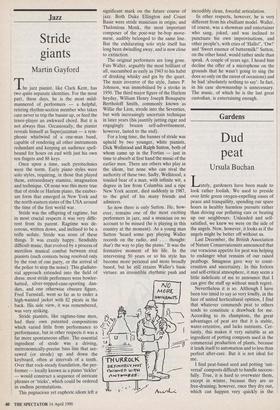Jazz
Stride giants
Martin Gayford
The jazz pianist, like Clark Kent, has two quite separate identities. For the most part, these days, he is the most mild- mannered of performers — a helpful, retiring rhythm-section member who takes care never to trip the bassist up, or feed the tenor-player an awkward chord. But it is not always thus. Occasionally, the pianist reveals himself as Superjazzman — a sym- phonic whirlwind of a one-man band, capable of rendering all other instruments redundant and keeping an audience spell- bound for hours on end with just his own ten fingers and 88 keys.
Once upon a time, such pyrotechnics were the norm. Early piano styles were solo styles, requiring, in those that played them, extraordinary stamina, imagination and technique. Of none was this more true that of stride or Harlem piano, the exuber- ant form that emerged in New York and the north-eastern states of the USA around the time of the first world war.
Stride was the offspring of ragtime, but in most crucial respects it was very diffe- rent from its parent. Ragtime was de- corous, written down, and inclined to be a trifle sedate. Stride was none of these things. It was crazily happy, fiendishly difficult music, that evolved by a process of merciless musical combat between rival pianists (such contests being resolved only by the rout of one party, or the arrival of the police to stop the noise). This gladiato- rial approach extended into the field of dress: most stride performers were bowler- hatted, silver-topped-cane-sporting dan- dies, and one otherwise obscure figure, Fred Turnstall, went so far as to order a high-waisted jacket with 82 pleats in the back. His side view, it was remembered, was very striking.
Stride pianists, like ragtime-time men, had their own patented compositions which varied little from performance to performance, but in other respects it was a far more spontaneous affair. The essential ingredient of stride was a driving, metronomically-precise bass line that see- sawed (or strode) up and down the keyboard, often at intervals of a tenth. Over that rock-steady foundation, the per- former — locally known as a piano 'tickler' — would construct a sequence of intricate phrases or 'tricks', which could be ordered in endless permutations.
This pugnacious yet euphoric idiom left a significant mark on the future course of jazz. Both Duke Ellington and Count Basie were stride musicians in origin; and Thelonious Monk, the most important composer of the post-war be-bop move- ment, audibly belonged to the same line. But the exhilarating solo style itself has long been dwindling away, and is now close to extinction.
The original performers are long gone. Fats Waller, arguably the most brilliant of all, succumbed as early as 1943 to his habit of drinking whisky and gin by the quart. The main inventor of the style, James P. Johnson, was immobilised by a stroke in 1950. The third major figure of the Harlem heyday, William Henry Joseph Bonaparte Bertholoff Smith, commonly known as Willie the Lion, strode into the Seventies, but with increasingly uncertain technique in later years (his jauntily jutting cigar and engagingly brazen self-advertisement, however, lasted to the end).
For a long time, the banner of stride was upheld by two younger, white pianists, Dick Wellstood and Ralph Sutton, both of whom came up in the Forties — just in time to absorb at first hand the music of the earlier men. There are others who play in the idiom, but none who can rival the authority of these two. Sadly, Wellstood, a tousled bear of a man, with infinite wit, a degree in law from Columbia and a ripe New York accent, died suddenly in 1987, to the grief of his many friends and admirers.
So now there is only Sutton. He, how- ever, remains one of the most exciting performers in jazz, and a musician on no account to be missed (he is playing in this country at the moment). As a young man Sutton 'heard some guy playing Waller records on the radio, and . . . thought: that's the way to play the piano.' It was the formative moment of his life. In the intervening 50 years or so his style has become more personal and more broadly based, but he still retains Waller's basic virtues: an irresistible rhythmic push and incredibly clean, forceful articulation.
In other respects, however, he is very different from his ebulliant model. Waller, of course, was a showman and entertainer who sang, joked, and was inclined to punctuate his own improvisations, and other people's, with cries of 'Halle, 'Ow!' and 'Sweet essence of buttermilk!' Sutton, on the other hand, would rather smile than speak. A couple of years ago, I heard him decline the offer of a microphone on the grounds that he wasn't going to sing (he does so only on the rarest of occasions) and he had 'absolutely nothing to say'. In fact, in his case showmanship is unnecessary. The music, of which he is the last great custodian, is entertaining enough.


















































 Previous page
Previous page